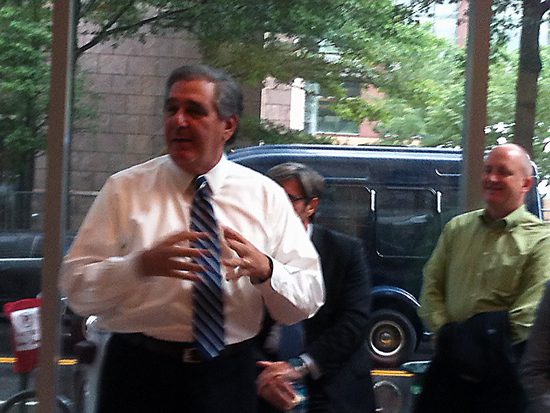Foxx’s ‘pep rally’ for consolidation

The event Tuesday afternoon was billed as Mayor Anthony Foxx hosting a “roundtable discussion on Regionalism & Reinvention” but it was, at heart, a dignified pep rally for consolidation.
Head cheerleader was Kentucky Lt. Gov. Jerry Abramson, formerly mayor of the unconsolidated Louisville and then of the consolidated Louisville-Jefferson County, Ky. Abramson described the years of work that went into that metro region’s consolidation effort. It took four votes, the last in 2000. The consolidation officially took place in January 2003.
|
Other articles on consolidation: |
Before merger Jefferson County had 83 incorporated cities. But, Abramson said, “You cannot solve 21st-century problems with a 19th-century government.”
He described the challenges of business location with two states (Kentucky and Indiana) and multiple political jurisdictions clamoring for new businesses. (A lucrative “occupation tax,” – essentially a business license tax – did not help promote cooperation. Abramson said the tax provides 56-58 percent of Louisville’s revenue.)
One facility, he said, located in what it thought was Louisville only to learn its land was half in Louisville, half in Jefferson County.
“In the old days, when something went wrong I always blamed it on the county,” he quipped.
Consolidation took four decades of debate. A 1982 proposal came within 1,600 votes of passing, he said. Proponents came back with another vote in 1983 which came within 2,300 votes. They did not give up. “It was obvious we weren’t going anywhere,” Abramson said, “because we couldn’t make any decisions.”
The newspaper’s editorial board was essential to the 2000 campaign, Abramson said, as was the business community. And the politically tricky task of designing the new districts for the new metro council? They got a University of Louisville geography professor to draw the districts, to remove politics from the process, Abramson said.
 Unlike the Indianapolis-Marion County consolidation in 1970, smaller towns weren’t allowed to opt out completely, Abramson said, although some maintain their incorporated status and offer various services to residents. But those residents still vote for metro council and metro mayor.
Unlike the Indianapolis-Marion County consolidation in 1970, smaller towns weren’t allowed to opt out completely, Abramson said, although some maintain their incorporated status and offer various services to residents. But those residents still vote for metro council and metro mayor.
After merger Louisville went from No. 67 in population rank – 256,000 in 60 square miles – to No. 16, with 741,000 residents now in all Jefferson County’s 386 square miles. The merged government has one mayor for 740,000 people as well as a 26-member metro council.
But, to quote comedian (and now U.S. senator) Al Franken, “What does that mean for me, Al Franken?” – or for Charlotte-Mecklenburg? We don’t have the tangle of local governments nor such a ferocious battle for business license tax revenues because our tax structure lacks a comparably lucrative revenue source from business taxes. We already have merged many government operations – which may be more efficient but is thoroughly confusing for residents. Got a problem with a park? Did you know you must call county government, not city? Garbage problem? Call City Council. But have a problem with schools? Don’t look to the mayor, or Charlotte City Council. Schools are run by a separate elected board, with money from the state legislature and the county.
Foxx has pushed the idea of consolidation, and last December the City Council in a narrow 6-5 vote agreed to study the issue, but only if Mecklenburg County commissioners agreed. They haven’t, yet. The city manager and county manager are not supportive of a study now. The council’s agreement to study the issue ends Dec. 31.
The press announcement said invitees to Tuesday afternoon’s roundtable discussion included the Charlotte City Council, Mecklenburg County commissioners, mayors of Mecklenburg County municipalities and local business and civic leaders. I didn’t spot any other mayors, and only one county commissioner, Jennifer Roberts. City Council members Patsy Kinsey and LaWana Mayfield were there, as was Charlotte Chamber president Bob Morgan. Michael Marsicano and Brian Collier of Foundation For The Carolinas attended, as well. If there is a study, it would be paid for with a $150,000 grant from the foundation’s Catalyst Fund.
Maybe other elected officials were in the back and I did not spot them? Or maybe any Charlotte-Mecklenburg consolidation remains, as Louisville’s was for so long, decades away from success.
Views expressed here are the author’s and not necessarily the views of the UNC Charlotte Urban Institute or the University of North Carolina at Charlotte.